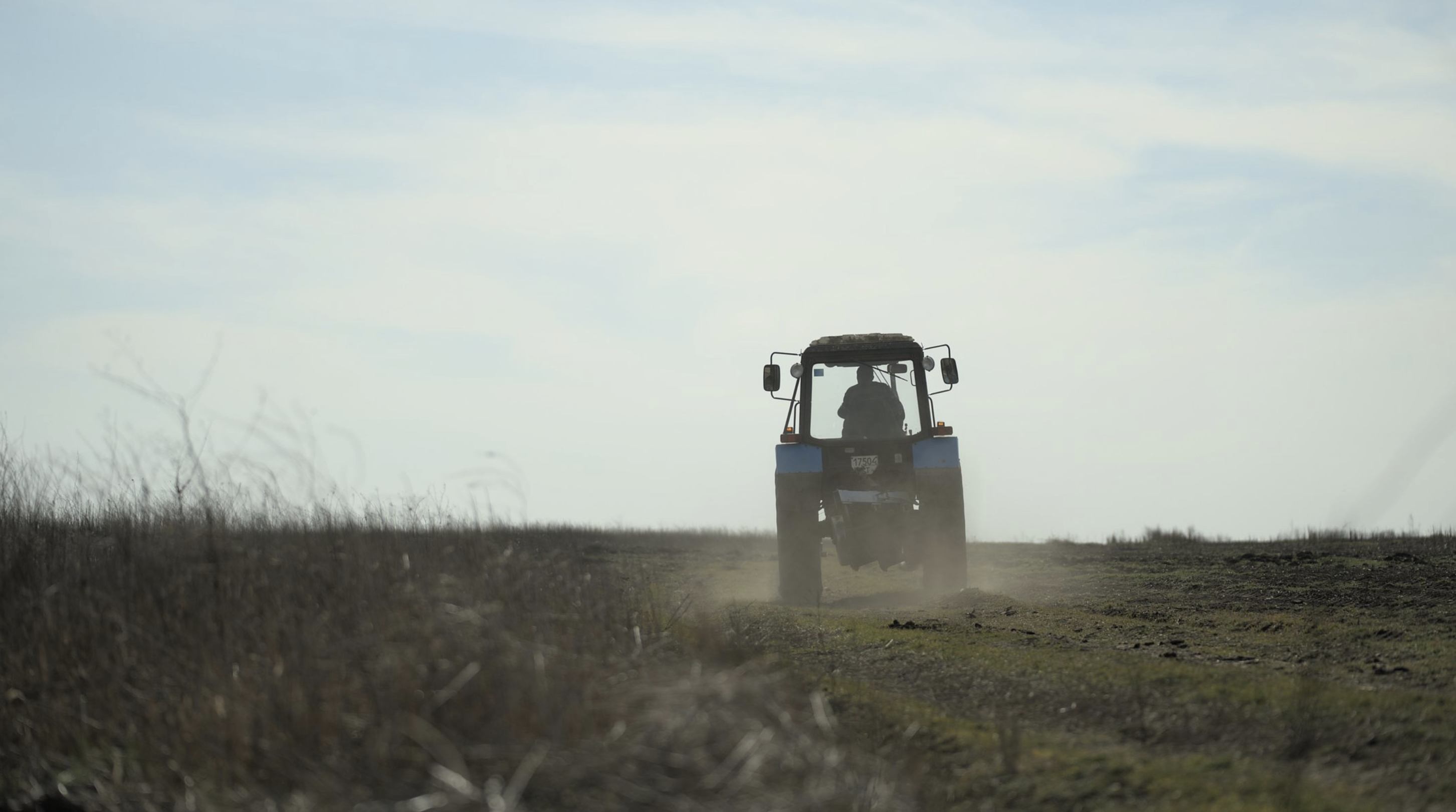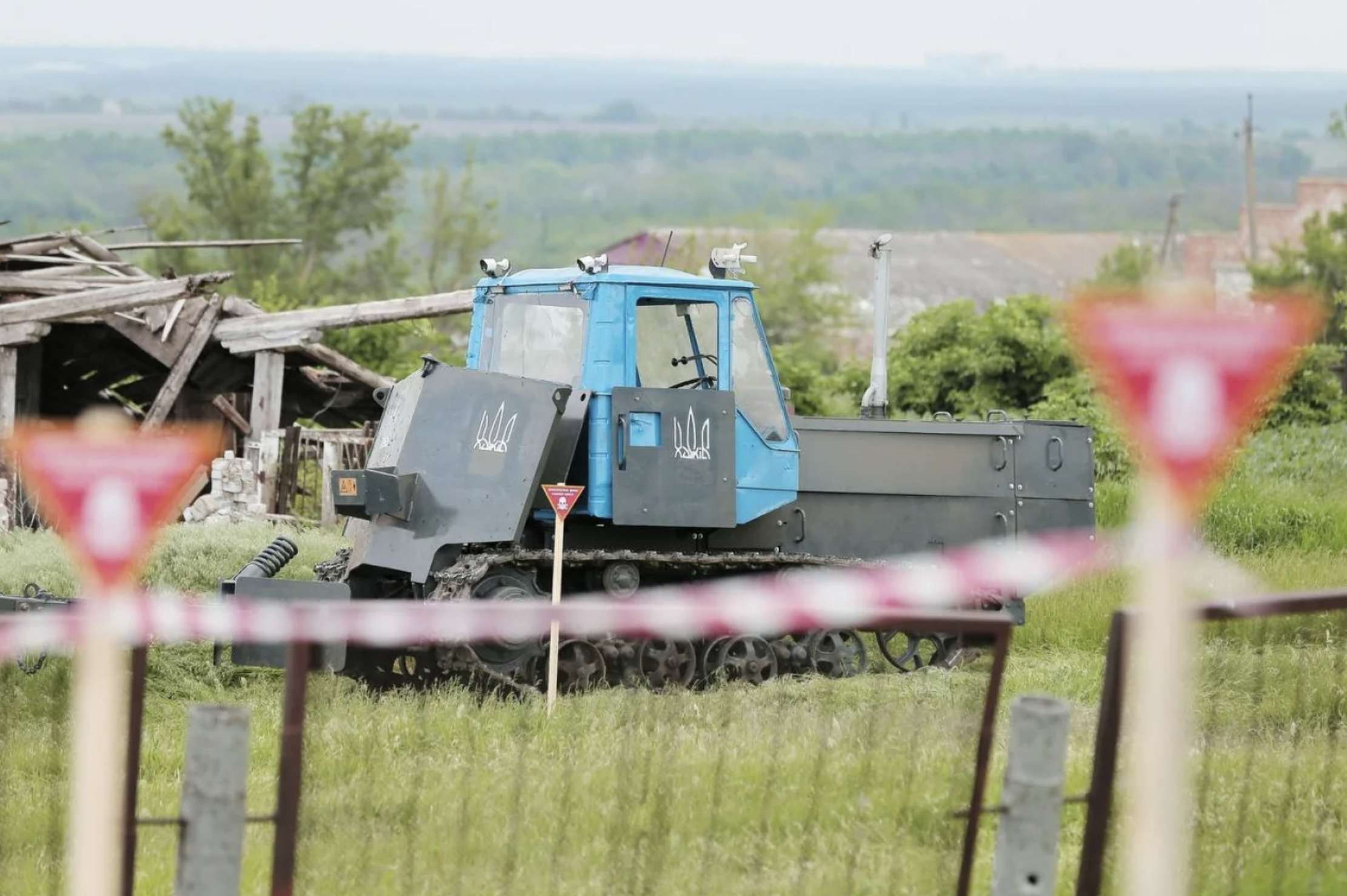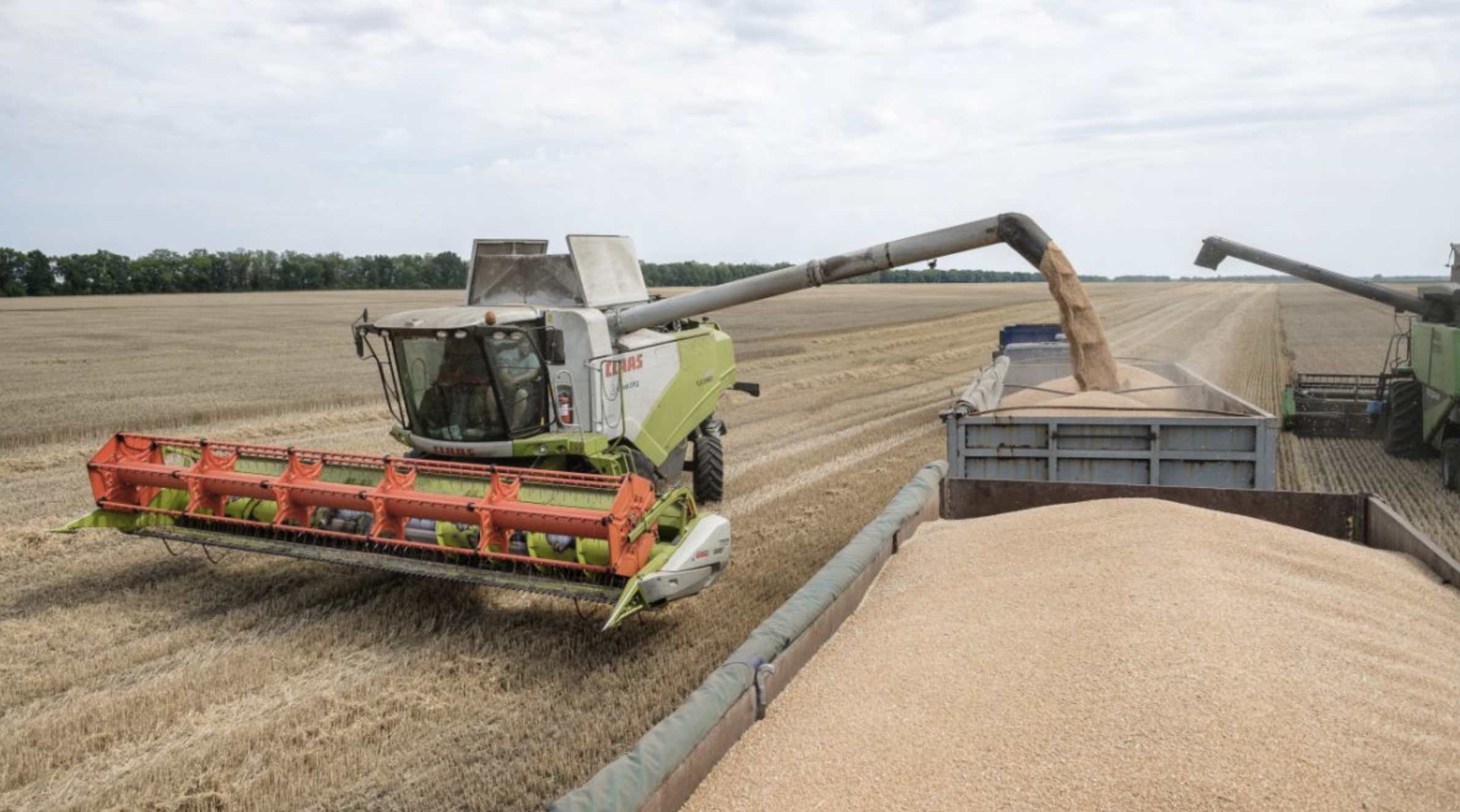What is the state of agriculture during wartime in Ukraine? What effects does the land reform have on the future of the country? And what a socially and ecologically just approach to postwar recovery of agriculture can look like?
We discuss these and other questions with Dr. Natalia Mamonova – Senior Researcher at RURALIS, Institute for Rural and Regional Research in Norway and a co-author of a study Ukrainian agriculture in wartime: resilience, reforms, and markets published by the The Transnational Institute (TNI).
In your work on Ukrainian agriculture, you argue that our country has a “bimodal agricultural structure,” in which large agribusinesses and small farms do not directly compete with each other for land and markets, allowing them to coexist for years. How did this happen and how does it work in practice?
Yes, there are two key types of agricultural producers in Ukraine. There is a large agribusiness which is primarily oriented on producing grain for export. It cultivates about 50% of all farmland and produces half of the gross domestic agricultural output. The other half is produced by family farmers and rural households who cultivate the remaining 50% of land. Family farmers and rural households produce 95% of potatoes, 85% of vegetables, 80% of fruits and berries, about 75% of milk and more than 35% of meat for personal consumption and sales on domestic markets. In addition to producing food for the Ukrainian market, family farmers are also increasingly interested in grain exports, but it’s hard for them to compete with large agribusiness, which controls all the bottlenecks there.
This bimodal agricultural structure is the result of multiple factors. One of which is the land reform. It was initiated after the collapse of the Soviet Union and aimed to distribute former collective lands to the rural population for private farming. The reform largely failed, and the land remained in reorganized collectives, which later metamorphosed into modern industrial enterprises and agroholdings. The 20-year moratorium on land sales secured the rights to land for Ukrainian villagers, who leased the distributed land to agribusiness for little money or in kind, while they themselves continued cultivating their household plots.
Thus, there have been no outright “land grabbing” and direct dispossession of smallholders in Ukraine to this day. But there is a “control grabbing”: agribusinesses control the agri-food value chain and receive most agricultural subsidies, thereby preventing family farmers and rural households from developing and becoming more profitable.
Another reason for the coexistence of large and small is a common belief that “big is beautiful”. It is partly rooted in Soviet history, partly imposed by the neoliberal capitalist order that favours big business, both structurally and ideologically. The belief has been in the minds of Ukrainian policy makers and was lobbied by agroholdings for many years. This made Ukraine the world's leading grain exporter. The belief was also shared by small-scale farmers until recently; they viewed their household farming as subsidiary, insignificant and, therefore, did not stand up for their rights and recognition.
The situation began to change after the Euromaidan revolution. Then, Ukraine broke up with its Soviet past and associated Russian influence, and stepped on its independent path towards the European future. In one of my projects, I interviewed rural Ukrainians two years before and two years after the Euromaidan. I observed how a new pro-European identity and growing patriotism led people to talk about family farming as the future model of Ukrainian agriculture that could feed Ukraine and Europe with ecological and healthy food. Indeed, family farmers and rural households in Ukraine are just as productive in terms of yields as large businesses, but use more environmentally friendly methods and local food networks, and, if enhanced, could become a sustainable alternative to chemical-dependent industrial agriculture.
Moreover, smallholders hoped that Ukraine's association with the EU, followed by its accession as a member state, would reduce corruption and weaken oligarchic influence on the domestic economy, open new markets for farm products of smallholders, and support the development of family-based farming in Ukraine. Overall, joining the EU meant a better life and fairer opportunities for many Ukrainians, not just rural dwellers.

Sowing in Novovorontsovka, Kherson region. Photo: Suspilne
The report argues that small family farms in Ukraine are critical not only to more ecologically and socially-responsible food production, but also to food security and food sovereignty in Ukraine during the full scale invasion by Russia. Could you talk a little about this?
Answer: The full scale war demonstrated the systemic fragility of the globalised neoliberal agriculture, which is characterised by narrow specialisation in agricultural production, dependence on international trade of food, fuel and fertilisers, and extreme reliance on just a few staples for most human diets.
Ukrainian export-oriented agriculture was paralysed in the early months of the war. Mountains of grain grew along the Ukrainian borders, when the Black Sea ports were blocked by the Russian navy, and land routes were insufficient to transport all the grain. In addition, supplies of fuel and fertilisers were stopped, since they had previously been imported from Russia and Belarus. And of course, there’s ongoing Russia’s bombing of agricultural fields, destruction of agricultural facilities and infrastructure. The list of destruction is endless! Large agribusiness was unable to quickly adapt to the shocks and challenges of war. Their complex logistics, high technology and large scale may be effective in times of peace, but not effective in times of war. Meanwhile, family farmers and rural households, those who are located outside the areas of active hostilities, were able to adapt relatively quickly and produce food to feed themselves, their communities, the army and the people in Ukraine.
How did they do this? Localised food systems are generally more resilient to global shocks, as they are less dependent on external resources and international trade. As the agricultural inputs got scarce, smallholders started using more manual labour and less machinery, sometimes ploughing fields with horses. They replaced chemical fertilisers with organic ones, and in the case of export-oriented farms they were able to quickly reorient themselves to the domestic market, producing, for example, buckwheat instead of corn. But the most important thing is solidarity, which helps the Ukrainian people survive in the most difficult times. Many rural communities are hosting internally displaced people who have fled war zones and large cities that are frequently targeted by Russian air strikes. Together people grow food, share resources, and support each other.
Thus, family farmers and rural households are those who feed Ukraine in peacetime and now in wartime. This also influences public attitudes towards small-scale farming. As I said earlier, more and more people believe that the family-based farming model should be the future of Ukraine. Now there are even more people who think so.

A machine for preparing soil for demining created by Kharkiv engineers. Photo: Telegram / Oleg Sinegubov
In the report, you point out that the land reform aimed at lifting a moratorium on the sale of farmland that had been in place since 2001, is one of the most controversial and politically sensitive reforms since independence. What have been its intentions and consequences so far, and what social, environmental and economic consequences of land market liberalisation will we see in the near future?
There are many voices for and against the land reform. And if not the war, liberalisation of the land market would have become the biggest issue in Ukrainian politics. The need to open the land market was justified by the fact that this would ensure the rights of land users, make agriculture more efficient, and bring more investment into Ukrainian agriculture. Opponents fear a land grab by big agribusiness and the disappearance of small-scale farming.
Liberalisation of the land market was planned to be carried out in two stages. From 2021 to 2024, only individuals could buy land, but not more than 100 hectares per person. After 2024, both individuals and legal entities are allowed to acquire up to 10 thousand hectares of land. The idea was a good one: a phased approach aimed at allowing family farmers and smallholders to buy land first and then provide market access to larger companies. But this did not take into account the fact that the full-scale war began when the market was open for only six months. During the first few months of the war, land reform was suspended, but then continued as planned.
I do believe that the land market should be liberalised, but with more support for family farmers and rural households in purchasing land, otherwise it will become like in Latin America, where latifundia control most of the land (see more here). Besides that the land reform should not be carried out during the war. How can we allow the sale of land when 30% of Ukrainian territories are now occupied, when 6.2 million refugees have left Ukraine, 5.1 million people are internally displaced, and many Ukrainian people, mostly men, are fighting at the front? These people cannot participate in land deals. And in general, the war created uncertainties and economic hardship for many Ukrainians. This results in distress land sales, when people sell their land plots due to the need to buy some basic stuff or pay for medical treatment. In better times they wouldn't sell their lands. Also, many family farmers do not have financial means to buy land that they currently rent from their neighbours. Meanwhile, large agribusinesses do have these means.
At this moment we do not see significant transformation in land ownership in Ukraine. Land transactions that are taking place now were mostly made a long time ago, and are now only legalised. However, if family farmers and rural households do not receive sufficient support to purchase land, we may see some changes in land use. And it is not necessarily the land grabs by large agroholdings. Agroholdings will certainly try to secure control over the lands they cultivate. But there are other actors, such as speculators, business tycoons and other non-agricultural investors, who could buy some of Ukrainian farmland in times of uncertainty.

Wheat harvest. Illustrative photo
All this will make life even more difficult for family farmers and rural households. This will affect the future of Ukrainian agriculture; it can become even more industrial and export-oriented. This, in turn, will compromise domestic food security, since family farmers and rural households are those who feed Ukraine in both war and peace. This will also affect the social life in the villages as family farming and rural households are the backbone of every village. And of course, the environment may suffer as industrial farming uses less environmentally friendly methods. But this is nothing in comparison with the impact of the war on Ukrainian agriculture, environment, and peoples’ lives.
I am interested in the consequences of dependence on Ukrainian food exports for farmers and food producers in Eastern and Central Europe, as well as in African countries, as a result of the full-scale war. Who was affected by these disruptions and how? How did the disruptions in Ukrainian agriculture caused by the war affect other regions of the world, those who consume Ukrainian products and those who compete with them?
Before the Russian invasion in 2022, Ukraine was the world's largest exporter of sunflower seeds (used to make sunflower oil and feed), the fourth largest exporter of barley and corn, and the seventh largest exporter of wheat. Grain from Ukraine was shipped all over the world. But the main recipients of Ukrainian grain were the food-insecure countries in Asia, Africa, the Middle East, which suffered the most from Russia’s blockade of Ukrainian Black Sea ports, through which 95% of Ukrainian grain exports used to be sent abroad. There, rates of food insecurity and malnutrition increased significantly. The UN claimed that the war has exacerbated famine in the Global South. However, I must note that this is not only due to the war, but also to climate change, the Covid-19 pandemic and internal conflicts.
The war caused not only physical disruptions in food trade, but also led to an increase in world food prices. Thus, world prices for grains, including wheat, barley and other cultures, have nearly doubled as Ukraine and Russia – the main grain exporting countries – fell out of international trade. Prices also jumped due to factors unrelated to production and distribution, such as speculation in global food markets, exchange rate fluctuations and export restrictions imposed by some other countries to maintain their food security. Today, 16 countries have introduced 22 food export bans, and 8 have introduced 15 export restriction measures.
Countries that do not directly depend on import of Ukrainian food also felt the severe consequences of the war. The war disrupted not only the food trade, but also the trade of fuel and fertilisers – Russia and Belarus used to be the main exporters of fertilisers and fuel to many countries. This caused a sharp increase in global fuel and fertiliser prices, which in turn affected food producers around the world. Industrial agricultural producers have been hit the hardest because they are critically dependent on fuels and chemical inputs. This, coupled with inflation and declining consumer purchasing power, has pushed many farmers to the brink of bankruptcy.
These days we are witnessing the largest farmer protests in the history of the European Union. The protests are caused by multiple factors, but the key cause is the deplorable economic situation of European farmers. In Eastern and Central Europe, farmers are protesting against the influx of Ukrainian food products, primarily grain. As I mentioned earlier, Russia's blockade of the Black Sea ports has led to Ukrainian grain being locked in the country. To solve this problem, the Ukrainian government, together with its European allies, initiated “Solidarity Lanes” to transfer Ukrainian grain through land and river routes to Europe for onward shipment to countries in the Middle East or Africa. However, a significant part of Ukrainian grain and oilseeds was sold to the EU. This was due to logistics bottlenecks, soaring costs of transport outside the EU, broken contracts with original buyers and, in some cases, shady practices that allowed some local players in Poland, Bulgaria, Hungary, Romania and Slovakia to profit from the sale of Ukrainian grain on local markets. The flow of relatively cheap Ukrainian grain into Eastern and Central Europe has depressed local prices and left local farmers unable to sell their crops.
In the EU, farmers and politicians who oppose increased imports of Ukrainian agricultural products focus on two points: the industrial nature of production in Ukraine, which makes it more economically competitive, and the dangers to the environment and health. Does this criticism only apply to large oligarchic holdings that dominate exports, and does not relate to smallholders?
Yes, you are right. Criticism towards Ukrainian export products is related to their price and production methods. This applies not only to grain from Ukraine, but also to other foods. In France, for example, farmers are protesting against honey from Ukraine. Ukrainian products are cheaper than those produced in the EU for various reasons. These are industrial production methods and economies of scale that make Ukrainian food more economically competitive. Ukrainian food producers do not have to comply with strict environmental requirements, as in the EU. Furthermore, land and labour are also cheaper in Ukraine. And above all, the EU introduced a temporary suspension of export duties and tariff quotas on Ukrainian agri-food products to support Ukraine during the war. All this affects the price of Ukrainian food products on European markets.
I would not say that protesting farmers and politicians in Europe seriously believe that Ukrainian products pose a danger to the environment and health. Ukrainian food exports are not hazardous, although Slovakia found traces of a pesticide banned in the EU in wheat from Ukraine last year. There were also precedents when Ukrainian grain for feed was sold in some countries of Eastern and Central Europe as grain for bakery. My colleagues in Poland revealed such cases. But there we must blame corruption in Poland, not Ukrainian grain.
Regarding your question about whether the criticism applies only to large oligarchic holdings or to smallholders as well: I am not sure that everyone in Europe understands that Ukrainian agriculture is fundamentally different from European agriculture and consists of two different types of producers. In European popular discourse, a very general phrase “food exports from Ukraine” is used. Only in Poland, Ukraine's closest neighbour, the protesting farmers have begun to claim that they were protesting not against Ukrainian farmers, but against transnational corporations operating in Ukraine. This is largely true, since agribusiness – the key exporters of Ukrainian grain – often belong to international holdings or foreign investment groups. Meanwhile, honey, for example, is produced by Ukrainian family farmers and commercially-oriented rural households that sell their products abroad. However, unfortunately, there is no distinction in the resentment of European farmers against cheaper Ukrainian exports.
There are multiple conversations taking place on the post-war recovery of Ukraine. Part of the National Recovery Council, a “New Agrarian Policy” group is currently developing proposals for the restoration of agriculture. Existing drafts seem to propose returning to the pre-war production and economic model of globalised export-oriented agriculture, instead of re-thinking food production from the perspectives of public good and ecological health and have been criticised by the civil society and academic community. What would a more just post-war agricultural recovery look like? How can healthy, culturally appropriate and produced with respect and care for the land food production be supported?
I don't think we should try to eliminate large-scale industrial agriculture in Ukraine at its core. It is too extreme and unrealistic. First, agribusiness generates budget revenues needed to rebuild the country after the war (before the war, the agricultural sector accounted for 45% of export earnings). Certainly, there are enough instances of large-scale tax evasions by agribusinesses, but we should not underestimate the role of big business in Ukraine’s economy. Second, the world is dependent on the grain from Ukraine and our country has the land, suitable climate and resources to remain the “breadbasket of the world.” However, I think, it is important to put more restrictions on big businesses, including environmental restrictions, and make agribusiness more transparent. It is also important that the Ukrainian government changes the priorities in its agricultural policy from a “big is beautiful” approach to supporting family farming and rural households. Of course, this is easier said than done since the bimodal agricultural structure, that is quite unjust towards smallholders, is deeply ingrained in the Ukrainian institutional system. This is evident in the New Agricultural Policy, which largely aims to recreate the pre-war model of globalised, export-oriented agriculture.
And, yes, there is a strong criticism from civil society, farmers organisations and academic community towards the governmental plans to recreate the previous agricultural system. The critics argue that the industrial export-oriented agriculture has shown its fragility and unsustainability, and it is time to prioritise family-based farming, which is environmentally and socially sustainable, economically viable, and resilient in times of crisis. Last year, activists and academics developed a “Resolution to the Government of Ukraine” with concrete recommendations to different state authorities on how to rebuild Ukrainian agriculture to make it more just and sustainable. The recommendations include adopting the UN Voluntary Guidelines for Responsible Governance of Tenure of Land, Fisheries and Forests, the FAO Principles for Responsible Investment in Agriculture and Food Systems, the UN Declaration on Peasants Rights. The authors also suggest certain mechanisms to support smallholders in buying agricultural land, and ask for a 10% quota for small-scale agricultural producers in the international grain trade as part of the Humanitarian Program “Grain from Ukraine”. You can read the complete recommendations in English and Ukrainian.

The international founding summit "International Summit on Food Security", which launched the "Grain from Ukraine" humanitarian program initiated by the president, on November 26, 2022. Photo: Office of the President
Moreover, there is also pressure from the EU. The government of Ukraine has an obligation to bring Ukrainian legislation and policies in line with EU and international standards, which should require additional efforts to improve the sustainability of Ukrainian agriculture, enhance the diversity of farming models (especially family-based agriculture), and promote rural development.
Compared to the industrial oligarchs, who are losing their influence, agrarian ones seem to be doing much better. A lot of the latter seem to be consolidating their power and control over land in Ukraine. What do you make of the current state of Ukrainian agricultural oligarchy?
The Ukrainian oligarchic system is quite vibrant, and individual oligarchs change their political priorities and enter into alliances depending on which government is in power. Agriculture is a key investment area for Ukrainian oligarchs. Large-scale industrial monoculture production generates quick profits, requires less investment, and millions of state money have been pouring into it for decades. Many oligarchs established close ties with state authorities, which allowed them to influence agricultural policy and negotiate better terms for their businesses. The clearest example of the merger of state and oligarchic interests is the presidency of Petro Poroshenko. Oligarch Poroshenko, formerly known as the “Chocolate King,” was the owner of a large agricultural company, Agroprodinvest, whose land acreage tripled during his presidency.
The current president Volodymyr Zelenskyy has taken a number of initiatives to de-oligarchise the Ukrainian economy and limit the political influence of oligarchs. Russia's war in Ukraine helped him in these efforts. First, many mega-large corporations experience severe difficulties because of Russia’s aggression and occupation. This largely applies to industrial businesses, such as metallurgy, mining in the east and south of Ukraine, or the pipe and railway business. Large-scale export-oriented agriculture is also experiencing structural problems because of the war (as I talked about this already). Second, Zelenskyy no longer needs the political and financial backing of oligarchs, and the searing experience of defending the country against Russian aggression is likely to make Ukrainians less keen to again kowtow to the mega-wealthy. Third, cutting corruption and strengthening the rule of law is also a condition for much of the aid pouring into Ukraine.
I don't think the war has put an end to the Ukrainian oligarchs, they are still too powerful. However, they may have to look for creative ways to reorganise their businesses to adapt to the new requirements and conditions that Ukraine must meet if it wants to join the EU. As we see now, Ukrainian oligarchs and big corporations are trying to influence the post-war recovery programs to keep the “big is beautiful" framework in place.
Thus, the Ukrainian government is now facing a serious dilemma: should it continue supporting the large-scale export-oriented model of agriculture that big business and oligarchs are lobbying for, and remain the “breadbasket of the world”? Or should the government refocus on family farming, which is socially, environmentally and economically sustainable and more resilient in times of crisis? The political response to this uneasy question will determine the future of Ukrainian agriculture and rural areas in the years to come.



